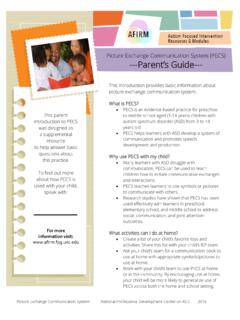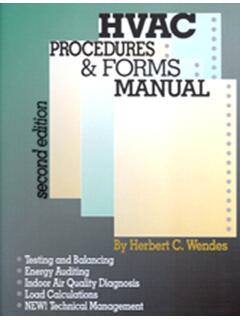Transcription of COGNITIVE BEHAVIORAL INTERVENTION (CBI) ---EBP Brief …
1 COGNITIVE BEHAVIORAL INTERVENTION (CBI) For more information visit: of the EBP Brief This evidence-based practice overview on COGNITIVE BEHAVIORAL INTERVENTION includes the following components: : A quick summary of salient features of the practice,including what it is, who it can be used with, what skills it has beenused with, and settings for : The CBI Evidence-base details the NPDC criteria forinclusion as an evidence- based practice and the specific studies that meet the criteria for this practice. Guide: Use the CBI Step-by-Step Practice Guide as anoutline for how to plan for, use, and monitor CBI. Each step includesa Brief description as a helpful reminder while learning the Checklist: Use the CBI Implementation Checklist todetermine if the practice is being implemented as Collection Sheets: Use the data collection sheets as a methodto collect and analyze data to determine if progress is being made fora learner with Sheet for Professionals: Use the CBI Tip Sheet for Professionalsas a supplemental resource to help provide basic information aboutthe practice to professionals working with the learner with Guide: Use the CBI Parent Guide to help parents or familymembers understand basic information about the practice beingused with their Resources: Use the Additional Resources to learn moreabout the Standards: A list of CEC Standards that apply specifically References: A list of numerical References utilized for theCBI citation: Mussey, J.
2 , Dawkins, T., & AFIRM Team. (2017). COGNITIVE BEHAVIORAL INTERVENTION . Chapel Hill, NC: National Professional Development Center on Autism Spectrum Disorders, FPG Child Development Center, University of North Carolina. Retrieved from http://afirm fpg unc edu/cogniItive BEHAVIORAL interventionThis overview Brief will support your use of the evidence-based practice: COGNITIVE BEHAVIORAL INTERVENTION . COGNI TIVE BEHAVIORAL INTERVENTION (CBI)---EBP Brief Packet--- COGNITIVE BEHAVIORAL InterventionNational Professional Development Center on ASD2017 1 of 29 What is CBI? Learners with ASD often struggle with understanding their emotions, thoughts, behaviors, as well as how they are all connected. Understanding and insight can be an area of difficulty for learners with ASD. COGNITIVE BEHAVIORAL interventions can be used to address foundational skills such as social skills, communication, behavior, cognition, coping, and emotional well-being/mental health conditions ( , anxiety, depression, anger).
3 In addition, once some of these foundational skills are addressed, effects may also be seen on adaptive behavior skills. Evidence-base COGNITIVE BEHAVIORAL INTERVENTION meets the evidence-based practice criteria set by NPDC with 1 single case design study and 3 group design studies. The practice has been effective for elementary (6-11 years) to high school-age learners (15-22 years) with ASD. Evidence-based practices (EBP) and studies included in the 2014 EBP report detailed how COGNITIVE BEHAVIORAL INTERVENTION can be used effectively to address: social, communication, joint attention, school readiness, play, vocational, and academic outcomes. How Is CBI Being Used? COGNITIVE BEHAVIORAL interventions can be used by professionals such as teachers, special educators, speech-language pathologists, paraprofessionals, counselors, and psychologists. Training could take place in a school, clinic, or other community-based setting. Parents and family members can also be included in the CBI efforts.
4 Parents and family members also can be invaluable in supporting the learning, generalization, and maintenance of skills by helping their child practice skills in the home and reinforcing the skills they see their child using across environments. For more information, visit: BEHAVIORAL INTERVENTION (CBI) COGNITIVE BEHAVIORAL InterventionNational Professional Development Center on ASD2017 2 of 29 COGNITIVE BEHAVIORAL INTERVENTION (CBI) The National Professional Development Center on ASD has adopted the following criteria to determine if a practice is evidence-based. The EBP Report provides more information about the review process (Wong et al., 2014). Efficacy must be established through high quality, peer-reviewed research in scientific journals using: randomized or quasi-experimental design studies (two high quality experimental or quasi-experimental group design studies), single-subject design studies (three different investigators or research groups must haveconducted five high quality single subject design studies), or combination of evidence [one high quality randomized or quasi-experimental group design studyand three high quality single subject design studies conducted by at least three differentinvestigators or research groups (across the group and single subject design studies)].
5 --OVERVIEW-- COGNITIVE BEHAVIORAL INTERVENTION teaches learners to examine their own thoughts and emotions, recognize when negative thoughts and emotions are escalating in intensity, and then use strategies to change their thinking and behavior. COGNITIVE BEHAVIORAL INTERVENTION meets the evidence-based practice criteria with 1 single case design study and 3 group design studies. The practice has been effective with learners in elementary school (6-11 years) to high school learners (15-22 years). Studies included in the 2014 EBP report detailed how COGNITIVE behavior INTERVENTION can be used effectively to address: behavior, social, communication, adaptive, mental, and COGNITIVE outcomes. In the table below, the outcomes identified by the evidence base are shown by age of participants. Early INTERVENTION (0-2) Preschool (3-5) Elementary (6-11) Middle (12-14) High (15-22) Social Social Communication Communication Behavior Behavior Behavior COGNITIVE COGNITIVE Adaptive Mental ---Evidence-base for COGNITIVE BEHAVIORAL INTERVENTION --- COGNITIVE BEHAVIORAL InterventionNational Professional Development Center on ASD2017 3 of 29 Early INTERVENTION (0-2 years) No studies Preschool (3-5 years) No studies Elementary (6-11 years) Drahota, A.
6 , Wood, J. J., Sze, K. M., & Van Dyke, M. (2011). Effects of COGNITIVE BEHAVIORAL therapy on daily living skills in children with high-functioning autism and concurrent anxiety disorders. Journal of Autism and Developmental Disorders, 41(3), 257-265. doi: *Sofronoff, K., Attwood, T., & Hinton, S. (2005). A randomised controlled trial of a CBT INTERVENTION for anxiety inchildren with Asperger syndrome. Journal of Child Psychology and Psychiatry, 46(11), 1152-1160. doi: *Sofronoff, K., Attwood, T., Hinton, S., & Levin, I. (2007). A randomized controlled trial of a COGNITIVE behaviouralintervention for anger management in children diagnosed with Asperger syndrome. Journal of Autism and Developmental Disorders, 37(7), 1203-1214. doi: Middle (12-14 years) *Singh, N. N., Lancioni, G. E., Manikam, R., Winton, A. S., Singh, A. N., Singh, J., & Singh, A. D. (2011). A mindfulness-basedstrategy for self-management of aggressive behavior in adolescents with autism. Research in Autism Spectrum Disorders, 5(3), 1153- 1158.
7 *Sofronoff, K., Attwood, T., & Hinton, S. (2005). A randomised controlled trial of a CBT INTERVENTION for anxiety inchildren with Asperger syndrome. Journal of Child Psychology and Psychiatry, 46(11), 1152-1160. doi: *Sofronoff, K., Attwood, T., Hinton, S., & Levin, I. (2007). A randomized controlled trial of a COGNITIVE behaviouralintervention for anger management in children diagnosed with Asperger syndrome. Journal of Autism and Developmental Disorders, 37(7), 1203-1214. doi: High (15-22 years) *Singh, N. N., Lancioni, G. E., Manikam, R., Winton, A. S., Singh, A. N., Singh, J., & Singh, A. D. (2011). A mindfulness-basedstrategy for self-management of aggressive behavior in adolescents with autism. Research in Autism Spectrum Disorders, 5(3), 1153-1158. * Research which included participants in multiple age Behavior INTERVENTION (CBI) COGNITIVE BEHAVIORAL InterventionNational Professional Development Center on ASD2017 4 of 29 COGNITIVE BEHAVIORAL INTERVENTION (CBI) ---Step-by-Step Guide--- This practice guide outlines how to plan for, use, and monitor the practice of COGNITIVE BEHAVIORAL INTERVENTION .
8 Keep in mind that COGNITIVE BEHAVIORAL INTERVENTION can be used to decrease inappropriate behaviors and increase appropriate behaviors and skills. BEFORE YOU Each of the following points is important to address so that you can be sure the selected EBP is likely to address the learning needs of your student. Have you found out more information about..? Establish a goal or outcome that clearly stateswhen the behavior will occur, what the target skill is, and how the team will know when the skill is Identify evidence-based the answer to any of these is no, review the process of how to select an EBP. For more information, visit: COGNITIVE BEHAVIORAL InterventionNational Professional Development Center on ASD2017 5 of 29 Now you are ready to Step 1: Planning The planning step explains initials steps and considerations involved when using CBI as an INTERVENTION for a learner. Determine if learner has prerequisite skills Due to the COGNITIVE and linguistic skills needed to engage in CBI, learners with ASD with whom CBI techniques have often been utilized have typically had intact intellectual and academic skills that are largely within the average range of functioning.
9 Often, necessary skills may include COGNITIVE developmental level above approximately 6 years, expressive and receptive language skills above approximately 6 years, reading level consistent with the level of written materials used, and if doing CBI in a group, being group ready (ability to learn information in a group format, demonstrate appropriate behavior in a group, etc.). Conduct a functional behavior assessment A Functional Behavior Assessment (FBA) should be conducted to aid in identifying the most likely function of the interfering behavior. Note: Check out the module on FBA for more information about this specific process. Use the FBA to gather information on an interfering behavior. Conduct an assessment of needs and skills To address the BEHAVIORAL piece of CBI, conducting a functional behavior assessment can often be helpful to gather information regarding the concerning or interfering behavior including the antecedents and consequences of that behavior. To address the COGNITIVE piece of CBI, assessing the learners learning style from a perspective of ASD can often be helpful in giving additional information as to why a behavior is occurring and the learner s COGNITIVE strengths and weaknesses in order to help develop the INTERVENTION strategies to be used or modify them as necessary.
10 Use the Needs & Skills Assessment Sheet to gather data about a learner s needs and skills. Use the CBI Planning Sheet as a companion for completing the planning step. Choose or create a CBI INTERVENTION There are a variety of COGNITIVE BEHAVIORAL INTERVENTION models and evidence-based treatment programs, including those that have been manualized or published, for children, adolescents, and adults to address a variety of issues. These may need to be individualized to the specific learner with ASD you are working with. COGNITIVE BEHAVIORAL InterventionNational Professional Development Center on ASD2017 6 of 29 COGNITIVE BEHAVIORAL INTERVENTION STEP-BY-STEP Step 1: Planning (continued) Obtain training and/or supervision for chosen CBI INTERVENTION An understanding of the fundamental tenets of CBI and its application in general is critical to accurate implementation of CBI strategies and techniques. Thus, this understanding is essential before using CBI in practice.











